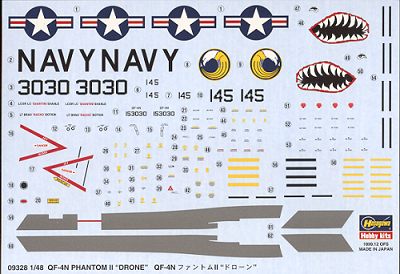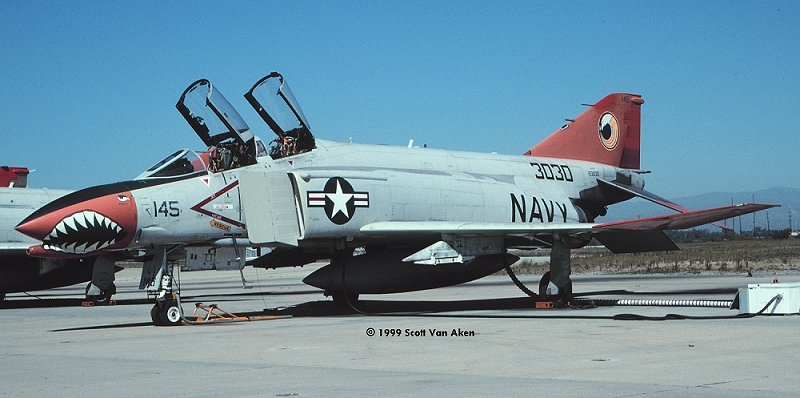
| KIT: | Hasegawa 1/48 QF-4N |
| KIT # | 09328 |
| PRICE: | $39.98 |
| DECALS: | One QF-4N as on the box top |
| REVIEW & | |
| NOTES: |

| HISTORY |

The QF-4 is basically a specially modified F-4 that can beoperated not only by a pilot, but as a NOLO (No Live Operator) aircraft. Whenunmanned, they are operated from the ground by qualified pilots flying via a TVand telemetry system. While both the USAF and USN drones (as unmanned aircraftare called) are expended as live fire targets, the Navy not only doesn't haveanywhere near the number of drones, but keeps them around for a lot longer thanthe USAF.
The Navy drone program is more geared to providing testing ofnew equipment and systems than the USAF, which used theirs almost exclusively asaerial targets. For the Navy, a Phantom drone will often be the first aircraftto test a new bomb or delivery system as well as testing and firing airbornelaunched subscale target missiles such as the MA-31 (Russian X-31 ASM). Those cases where a malfunction in the equipment could be dangerous fora live pilot. Only after many years, when the airframe has reached the end ofits useful life (for an F-4, this is generally around 5,000 flight hours), it isthen expended as a target.
The first Phantoms to be 'droned' were the F-4B. Those werepainted in overall high visibility orange and extremely colorful. The nextaircraft were the F-4N. These were generally left in the gloss gull grey orrepainted as such with the orange on the radome, wings, stabilizers and tail.The F-4N program is nearing its end with only about a handful of QF-4Ns still inservice as of late 1999. The next generation of Naval Phantom drones is theQF-4s. These still have the orange bits, but the rest of the airframe isgenerally in the Naval Tactical Scheme of matte greys.
All of the Navy's drones are converted at NARF Cherry Point, NCand then flown to Point Mugu, CA where they are then farmed out to variousplaces needing a drone, such as China Lake, CA or Puerto Rico. At the low rateof destruction of the Navy drones, it is not unthinkable that there will stillbe Phantoms in the air ten years from now. As to what will be next after thelast F-4 is gone; it is probably going to be another Navy aircraft. Air Forcefighters generally don't have strong enough landing gear to handle the remotelypiloted landings so put your money on the F-18!
| THE KIT |
It has been nearly 20 years since Hasegawa first brought out their1/48 Phantom series. Though without engraved panel lines and all of them havingUSAF cockpits, they were harkened as the best F-4 kit ever done. I can rememberpaying the then outrageous price of $22 for my first Hasegawa Phantom kit, anF-4B/N that I made using the 'Supersonic Canopener' markings of VF-51 that camein the kit. Back then, I was blissfully ignorant of such minutiae as propercockpits and the desirability of engraved panel lines. I had recently becomesomewhat proficient with an airbrush and was able to spray a kit without makingtoo much of a mess. Looking at that kit now, I am amazed at how far I haveprogressed!!
 Opening the box ofthis kit, I was immediately taken back to those days. Here was that same kit! Ithas changed a bit, this version having separate canopy sections so you candisplay the canopy open, something the other kit didn't have. But other thanthat and a different decal sheet, it is unchanged. One still has the USAFcockpit and raised panel lines. There are no additional parts in the kit to makeit a drone, but really, that isn't anything too difficult to change. BTW, if youwill notice the port and starboard images of '030 above and below, you willnotice that the tail markings are not handed as shown on the decal sheet. Thosemarkings on the QF-4N are themselves decals and only face in one direction!
Opening the box ofthis kit, I was immediately taken back to those days. Here was that same kit! Ithas changed a bit, this version having separate canopy sections so you candisplay the canopy open, something the other kit didn't have. But other thanthat and a different decal sheet, it is unchanged. One still has the USAFcockpit and raised panel lines. There are no additional parts in the kit to makeit a drone, but really, that isn't anything too difficult to change. BTW, if youwill notice the port and starboard images of '030 above and below, you willnotice that the tail markings are not handed as shown on the decal sheet. Thosemarkings on the QF-4N are themselves decals and only face in one direction!
The parts are still very well molded. Only a bit of flash on acouple of the sprues; nothing that won't take more than a second to remove. Youget both USAF and USN burner cans as a sprue or two are used in all Phantomkits. There are no sink marks readily noticeable and there are no ejector pinmarks that are too difficult to clean up. In fact, it is only on tubularstructures like landing gear and various pistons where you see any that needattention.
Since this is an early Navy Phantom, you get the flat wing top,and non-bulged doors that are proper for the F-4B/N. You'll also find the ECMfairings for the intakes. The wheels are on a common sprue marked 'F-4B,N,J soI'm not sure if they are skinny enough for the B/N kit as the J had fatterwheels. There is also a full missile load, including four Sparrows and eightSidewinders (four early ones for the B and four later ones for the J), alongwith the appropriate pointy Navy inner pylons. Also included are wing and bellytanks and the outer wing racks. The missiles and outer wing racks can be putinto the spares box if doing the kit markings as the drones have no need forthese, though you may want to modify some of the Sidewinders into trainingshapes.

| CONSTRUCTION |
The first thing that needs to be done is to get a new cockpit set as the one forthe kit is the USAF type and the back seat was VERY different between the two!
| PAINT & DECALS |
| CONSTRUCTION CONTINUES |
| CONCLUSIONS |
| REFERENCES |
Many thanks to Marco Polo Importers forsupplying the review kit.
If you would like your product reviewed fairly and fairly quickly by a site that has over 800 visits a day, please contact me or see other details in the Note toContributors.